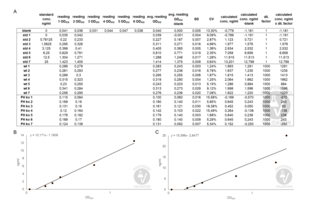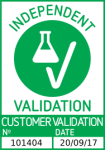Complement Factor H ELISA Kit
Kurzübersicht für Complement Factor H ELISA Kit (ABIN2859252)
Target
Alle Complement Factor H (CFH) ELISA Kits anzeigenBindungsspezifität
Reaktivität
Nachweismethode
Methodentyp
Detektionsbereich
Applikation
Proben
-
-
Untere Nachweisgrenze
- 0.78 ng/mL
-
Verwendungszweck
- Sandwich High Sensitivity ELISA kit for Quantitative Detection of Mouse Complement H/CFH
-
Marke
- PicoKine™
-
Analytische Methode
- Quantitative
-
Spezifität
- NSO, S875-V1252
-
Kreuzreaktivität (Details)
- There is no detectable cross-reactivity with other relevant proteins.
-
Sensitivität
- <20pg/mL
-
Benötigtes Material
- Microplate reader in standard size. Automated plate washer. Adjustable pipettes and pipette tips. Multichannel pipettes are recommended in the condition of large amount of samples in the detection. Clean tubes and Eppendorf tubes. Washing buffer (neutral PBS or TBS). Preparation of 0.01M TBS: Add 1.2g Tris, 8.5g Nacl
-
Immunogen
-
Expression system for standard: NSO
Immunogen sequence: S875-V1252
-
-
-
-
Applikationshinweise
- Before using Kit, spin tubes and bring down all components to bottom of tube. Duplicate well assay was recommended for both standard and sample testing.
-
Kommentare
-
Tissue Specificity: Expressed by the liver and secreted in plasma.
-
Plattentyp
- Pre-coated
-
Protokoll
- mouse CFH ELISA Kit was based on standard sandwich enzyme-linked immune-sorbent assay technology. A monoclonal antibody from rat specific for CFH has been precoated onto 96-well plates. Standards (NSO, S875-V1252) and test samples are added to the wells, a biotinylated detection polyclonal antibody from goat specific for CFH is added subsequently and then followed by washing with PBS or TBS buffer. Avidin-Biotin-Peroxidase Complex was added and unbound conjugates were washed away with PBS or TBS buffer. HRP substrate TMB was used to visualize HRP enzymatic reaction. TMB was catalyzed by HRP to produce a blue color product that changed into yellow after adding acidic stop solution. The density of yellow is proportional to the mouse CFH amount of sample captured in plate.
-
Testdurchführung
-
Aliquot 0.1 mL per well of the 50 ng/mL, 25 ng/mL, 12.5 ng/mL, 6.25 ng/mL, 3.12 ng/mL, 1.56 ng/mL, 0.78 ng/mL mouse CFH standard solutions into the precoated 96-well plate. Add 0.1 mL of the sample diluent buffer into the control well (Zero well). Add 0.1 mL of each properly diluted sample of mouse cell culture supernates, serum or plasma(heparin, EDTA) to each empty well. See "Sample Dilution Guideline" above for details. We recommend that each mouse CFH standard solution and each sample is measured in duplicate.
-
Testpräzision
-
- Sample 1: n=16, Mean(ng/ml): 14.5, Standard deviation: 0.710, CV(%): 4.9
- Sample 2: n=16, Mean(ng/ml): 31.8, Standard deviation: 1.844, CV(%): 5.8
- Sample 3: n=16, Mean(ng/ml): 41.2, Standard deviation: 2.760, CV(%): 6.7,
- Sample 1: n=24, Mean(ng/ml): 15.5, Standard deviation: 0.837, CV(%): 5.4
- Sample 2: n=24, Mean(ng/ml): 34.2, Standard deviation: 2.120, CV(%): 6.2
- Sample 3: n=24, Mean(ng/ml): 42.5, Standard deviation: 3.102, CV(%): 7.3
-
Beschränkungen
- Nur für Forschungszwecke einsetzbar
-
-
- by
- Alexander Lab, Jacobs School of Medicine and Biomedical Sciences, Department of Medicine, University of Buffalo
- No.
- #101404
- Datum
- 20.09.2017
- Antigen
- Commplement Factor H
- Chargennummer
- Validierte Anwendung
- ELISA
- Positivkontrolle
- C57BL/6 mouse serum
- Negativkontrolle
- Complement Factor H knockout mouse serum
- Bewertung
- Passed. ABIN2859252 detects complement factor H in C57BL/6 mouse serum samples.
- Primärantikörper
- Sekundärantikörper
- Full Protocol
- Centrifuge blood obtained from mice using EDTA was, separate serum and store serum at -80°C.
- Dilute serum 1:1000 in DILUENT and add 10µl to each well. Add 90µl of diluent to each well.
- Dilute the mouse CFH standard provided with the kit twofold from 0.78-25ng/ml according to the kit manual. Add 100µl of the diluted standard to each well.
- Run both standard and samples in duplicate.
- Use diluent buffer as blank.
- Cover the plate and incubate for 90min at 37°C.
- Discard the liquid and wash the plate with 3x with PBS.
- Add 100µl biotinylated anti-mouse FH antibody working solution into each well.
- Incubate the plate for 60min at 37°C.
- Wash the plate 3x with PBS.
- Added 100µl of ABC working solution into each well and incubated at for 30min at 37°C.
- Wash plate 3x with PBS.
- Discard the liquid and dry plate by blotting.
- Add 90µl of TMB color developing agent provided with the kit and incubate the plate for 30min at 37°C.
- Added 100µl prepared TMB stop solution.
- Read OD450 after 20min using a BioRad iMark Microplate reader.
- Anmerkungen
The signal in the positive controls samples was significantly higher than the blank whereas the signal from the negative control samples was higher than the baseline.
The serum obtained from knockout mice also had absorption. Complement Factor H is a family of proteins. It is possible that the antibodies utilized for the sandwich ELISA binds to the smaller members of the family that was not deleted in the knockout. The may need more standardization with the serum since some samples from the knockout gave background.
The linear range of the kit appears to be between 0.78 and 12.5ng/ml: the highest concentration standard (25ng/ml) lies off the best fit straight line generated for the lower concentration standards (see figure B and C). The CFH concentration in the sample was therefore calculated based on the equation for the best fit straight line not taking the 25ng/ml data point into account.
Validierung #101404 (ELISA)![Erfolgreich validiert 'Independent Validation' Siegel]()
![Erfolgreich validiert 'Independent Validation' Siegel]() Validierungsbilder
Validierungsbilder![A OD450 measurements for the diluted standard supplied with kit ABIN2859252, blank samples, and positive and negative control samples and the corresponding calculated concentrations. B Standard curve reflecting a twofold dilution series of the kit standard between 0.78ng/ml and 12.5ng/ml. C Standard curve based on the serial standard dilutions ranging from 0.78ng/ml to 25ng/ml.]() A OD450 measurements for the diluted standard supplied with kit ABIN2859252, blank samples, and positive and negative control samples and the corresponding calculated concentrations. B Standard curve reflecting a twofold dilution series of the kit standard between 0.78ng/ml and 12.5ng/ml. C Standard curve based on the serial standard dilutions ranging from 0.78ng/ml to 25ng/ml.
Protokoll
A OD450 measurements for the diluted standard supplied with kit ABIN2859252, blank samples, and positive and negative control samples and the corresponding calculated concentrations. B Standard curve reflecting a twofold dilution series of the kit standard between 0.78ng/ml and 12.5ng/ml. C Standard curve based on the serial standard dilutions ranging from 0.78ng/ml to 25ng/ml.
Protokoll -
-
Handhabung
- Avoid multiple freeze-thaw cycles.
-
Lagerung
- -20 °C,4 °C
-
Informationen zur Lagerung
- Store at 4°C for 6 months, at -20°C for 12 months. Avoid multiple freeze-thaw cycles
-
Haltbarkeit
- 12 months
-
-
- Complement Factor H (CFH)
-
Andere Bezeichnung
- CFH
-
Hintergrund
-
Protein Function: Factor H functions as a cofactor in the inactivation of C3b by factor I and also increases the rate of dissociation of the C3bBb complex (C3 convertase) and the (C3b)NBB complex (C5 convertase) in the alternative complement pathway. .
Background: Complement factor H (CFH), originally known as beta-1H globulin, is a serum glycoprotein that regulates the function of the alternativecomplement pathway in fluid phase and on cellular surfaces. It binds to C3b, accelerates the decay of the alternative pathway convertase C3bBb, and also acts as a cofactor for complement factor I, another C3b inhibitor. The CFH gene is located on chromosome 1q32-q32.1 within a cluster of genes encoding the regulatory complement components of the activation of C3 (RCA for 'regulators of complement activation'). This gene cluster includes decay-accelerating factor (DAF), C4-binding protein (C4BPA and C4BPB), and the factor H-related genes CFHR1, CFHR2, CFHR3, CFHR4, and CFHR5, among others. The gene family has arisen by multiple duplication events.
Synonyms: Complement factor H,Protein beta-1-H,Cfh,Hf1,
Full Gene Name: Complement factor H
Cellular Localisation: Secreted. -
Gen-ID
- 12628
-
UniProt
- P06909
-
Pathways
- Komplementsystem, Cellular Response to Molecule of Bacterial Origin
Target Alle Complement Factor H (CFH) ELISA Kits anzeigen
-


 (1 Validierung)
(1 Validierung)



